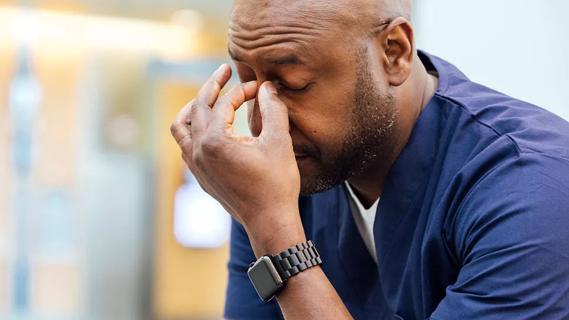This analogy can help you explain the daily struggle of chronic pain

If you live with chronic pain, you know how debilitating it can be. Some days, you wake up with no energy at all; every little action takes an unbearable amount of effort.
“Spoon theory” is a way for people who live with chronic pain to express how health issues impact their ability to complete everyday tasks and activities. Clinical psychologist Becky Bikat Tilahun, PhD, explains spoon theory and the relationship between chronic pain and activity.
Advertisement
Cleveland Clinic is a non-profit academic medical center. Advertising on our site helps support our mission. We do not endorse non-Cleveland Clinic products or services. Policy
Being in pain is exhausting, and if you live with chronic pain, you may find yourself having to carefully manage your daily activity levels to accommodate and anticipate your pain levels. That pain — and the logistics of managing it — can have an impact on your mental and physical bandwidth.
Enter spoon theory, developed in 2003 by writer Christine Miserandino. To explain how having lupus impacts her ability to perform daily tasks, Miserandino created an analogy about having a limited number of daily “spoons.”
People with chronic pain, she says, start each day with a set number of proverbial spoons, each one representing the physical and mental energy it takes to complete a daily task or activity. Smaller tasks, like showering or getting dressed, may cost only one spoon, while larger tasks, like cooking or vacuuming, may take three or four spoons. On days with increased pain, even smaller tasks may require multiple spoons.
“The spoon theory is a self-pacing strategy that emphasizes the need for chronic pain patients to work to a certain quota,” Dr. Tilahun says. “Patients have to be economical in how they spread the use of their spoons in their daily activity.”
Imagine, for example, a mother who lives with chronic pain. If she uses all of her spoons on daytime tasks, she’s left with no spoons to tend to her children at night. But she has to take care of her kids — so she pushes beyond her limits, borrowing spoons from tomorrow’s set amount to make it through today.
Advertisement
She’ll have to pay for it tomorrow, though, when she starts out with fewer spoons for all of that day’s activities and tasks. Today’s overexertion will result in tomorrow’s pain, fatigue and inactivity.
People who live with chronic pain and subscribe to spoon theory may refer to themselves as “spoonies.” But the term isn’t limited to any one medical condition. Rather, it’s a way for anyone who lives with chronic pain to explain the way they ration their energy based on their illness.
Some chronic illnesses associated with chronic pain include:
And spoon theory isn’t just for people with physical ailments. It can also be a helpful way for people with mental health conditions, including anxiety and depression, to think about their daily capacity.
Research shows that chronic pain can have wide-reaching impacts on physical and mental health.
“Chronic pain can interfere with normal brain activity, suppressing brain function such as motor coordination and learning,” Dr. Tilahun says. “Chronic pain can also disrupt the normal brain’s communication by causing sensitivity, so that even when the injury or illness that caused the initial pain ceases, the pain may endure.”
Other issues associated with chronic pain include:
While most people have unlimited energy to complete their daily responsibilities — including getting up in the morning, doing household chores, going to work and maintaining a social life — people with chronic pain have limited energy to perform those responsibilities without triggering a pain flare-up.
“Chronic pain patients walk a fine line between under-exertion and over-exertion when it comes to their daily engagement with activity,” Dr. Tilahun says.
Under-exertion means avoiding activities for fear of triggering pain and exhaustion. Over-exertion is when you engage in excessive activity, which can trigger a pain flare-up that impacts your capacity for the days to come.
“Most people with chronic pain experience good and bad days, as their pain intensity varies depending on the day,” Dr. Tilahun explains. “On a good day, they tend to overwork, which is followed by several days of ‘crashing,’ or feeling fatigued and in pain.”
To avoid these extremes, patients have to learn to balance their activity level each day, minding their limited energy and not exceeding their daily limits of activity.
Advertisement
Even though chronic pain cannot be cured, there are strategies and treatments that can help you learn to live with it.
“Studies show that with the right interventions chronic pain patients can improve their tolerance of the pain and restore their normal function,” Dr. Tilahun says.
“Based on the cause and nature of your pain, a comprehensive interdisciplinary approach — one that combines medication, physical therapy and counseling — can help most patients to rehabilitate and restore their function,” Dr. Tilahun says. “With the right interventions and therapies, their quality of life can be restored despite the pain.”
Advertisement
Learn more about our editorial process.
Advertisement

Pain is the distinguishing factor for determining if you have fibromyalgia

Setting the record straight: Diagnosis, treatment + more

Misleading claims, lack of scientific evidence and the risk of over-doing it are all concerns

Among the options is a fast-acting medication that offers relief in as little as 15 minutes

Both can help reduce pain, but they’re very different in terms of origins, philosophies and practices

Many factors, like dehydration, a cold or even your medication, can result in these common symptoms

Type 2 diabetes isn’t inevitable with these dietary changes

Applying a hot or cold compress can help with pain